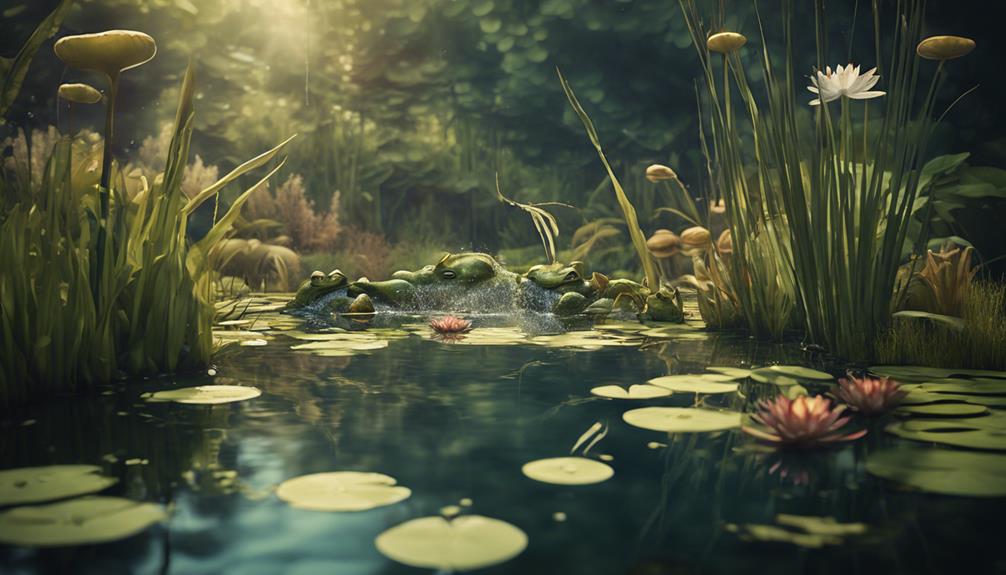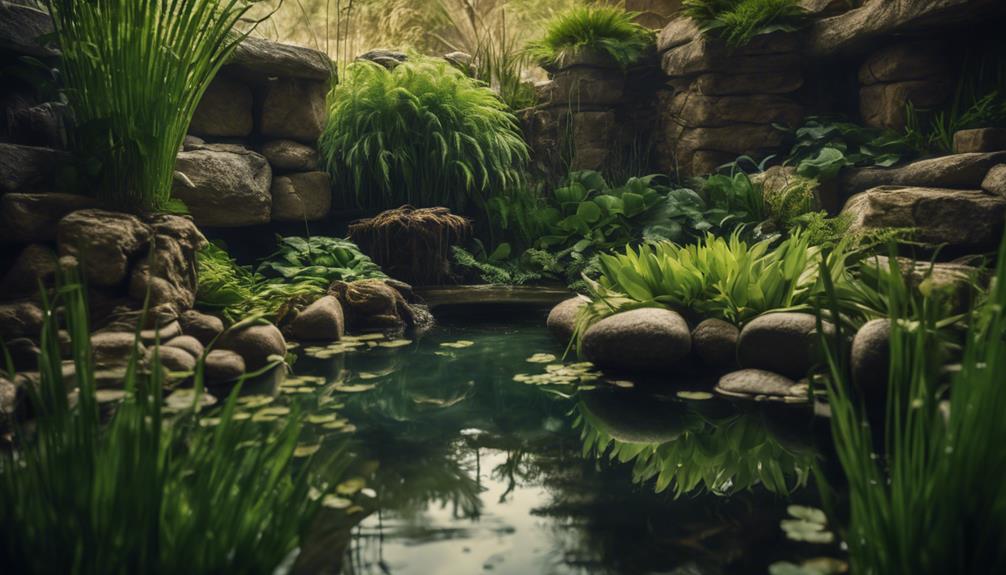When incorporating aquatic plants into your water feature design, consider the trifecta of shade, algae control, and habitat creation. For shade, you'll want plants like Cardinal Flower, Mosaic Plant, and Water Lettuce, which thrive in partial shade. To control algae, opt for Water Lettuce, Hornwort, or Mosaic Plant, which absorb excess nutrients. Finally, create a habitat for wildlife with plants like Cardinal Flower, Water Lettuce, and Bog Plants, which attract pollinators, provide shelter, and offer a food source. By choosing the right plants, you'll create a thriving ecosystem that supports a diverse range of wildlife, and you'll want to explore more about the specific needs and benefits of each species.
Table of Contents
Key Takeaways
- Cardinal Flower is an excellent choice for water features in USDA zones 5-11, thriving in partial shade with constantly wet roots.
- Water Lettuce is a great option for zones 10, tolerating partial shade and controlling algae growth by absorbing excess nutrients.
- Mosaic Plant is suitable for zones 8-11, providing shade and absorbing excess nutrients while creating a habitat for aquatic life.
- Consider Hornwort for its ability to increase oxygen levels, making it difficult for algae to thrive in a water feature.
- Choose plants that meet specific lighting requirements, as some aquatic plants require full sun to partial shade for optimal growth.
Aquatic Plants for Shade
When creating a thriving aquatic ecosystem in shaded areas, you'll want to select plants that can tolerate low-light conditions, and several species of aquatic plants are well-suited for these environments.
For instance, the Cardinal Flower thrives in partial shade with its roots constantly wet, making it an excellent choice for USDA zones 5-11.
Water Lettuce, on the other hand, tolerates partial shade and grows best in USDA zone 10.
Mosaic Plant, a tropical floating aquatic plant, can grow in partial shade and thrives in hardiness zones 8-11, but requires full sun to partial shade.
Japanese Sweet Flag Grass, an ornamental grass, can also grow in partial shade and thrives in USDA zones 6-9.
When selecting aquatic plants for shaded areas, it's vital to keep in mind the specific lighting requirements for each species so they receive the necessary amount of sunlight.
While some plants like Lotus can tolerate shade, most aquatic plants require at least partial sunlight to bloom and thrive.
Plants for Algae Control
By incorporating specific aquatic plants into your water feature, you can harness their natural abilities to control algae growth and maintain a thriving ecosystem.
For instance, Water Lettuce is an effective algae controller, as it absorbs excess nutrients from the water, reducing the likelihood of algae growth. Similarly, Hornwort increases oxygen levels, making it difficult for algae to thrive.
Water Clover out-competes algae for nutrients, while Mosaic Plant provides shade and absorbs excess nutrients, further controlling algae. Submerged plants like Cabomba absorb excess nutrients and provide shade, reducing algae growth.
Even carnivorous plants like Bladderwort and Pitcher Plant can help by consuming small organisms that contribute to algae growth.
By incorporating these aquatic plants into your water feature, you can create a natural filter that absorbs excess nutrients, reducing algae growth and maintaining clear water. This not only improves water quality but also enhances the overall aesthetic of your water feature.
Habitat Creators for Wildlife

Among the most valuable benefits of incorporating aquatic plants into your water feature is their ability to create habitats that support a diverse range of wildlife, from pollinators like hummingbirds to aquatic creatures like fish and amphibians. By choosing the right plants, you can create a thriving ecosystem that attracts and supports a variety of species.
Cardinal Flower: Attracts pollinators like hummingbirds and provides a habitat for aquatic life.
Water Lettuce and Mosaic Plant: Offer shelter and hiding places for fish and other aquatic creatures.
Bog Plants: Create a habitat for insects like dragonflies and damselflies, and provide a food source for birds and small mammals.
Lotus and Water Lilies: Provide a habitat for aquatic life, offering shelter and food for various aquatic creatures.
Frequently Asked Questions
What Plants Are Good for Water Features?
When designing your water feature, you'll want to think about plants that thrive in your water depth, complement plant containers, and enhance aquatic themes, creating focal points that attract wildlife, maintain ecosystem balance, and promote water clarity, all while adapting to seasonal changes.
What Plants Can Grow Fully Submerged in Water?
As you explore the world of aquatic plants, you'll find that only a few species can thrive fully submerged in water, including Bladderwort, Hornwort, and Cabomba, perfect for creating Deepwater Gardens and Freshwater Favorites in your Sunken Gardens.
Can I Put Plants in My Water Fountain?
As you ponder adding greenery to your water feature, rest assured you can put plants in your water fountain, but consider fountain maintenance, water clarity, and size to guarantee the right plant selection thrives in your unique environment.
What Are the Most Beautiful Pond Plants?
You'll love the vibrant Lily Varieties and Colorful Blooms of Water Hyacinth, transforming your pond into a stunning Aquatic Landscape with Floating Gardens, Pond Edges, and Flowering Rushes, creating an Aquatic Art masterpiece that reflects beauty and invites you to escape into nature.
Conclusion
As you craft your water feature design, incorporating these three aquatic plants will elevate its aesthetic and ecological appeal.
By introducing shade-providing species, you'll reduce algae growth and create a haven for wildlife.
These plants will harmoniously coexist, fostering a balanced ecosystem that's both visually stunning and environmentally sustainable.

